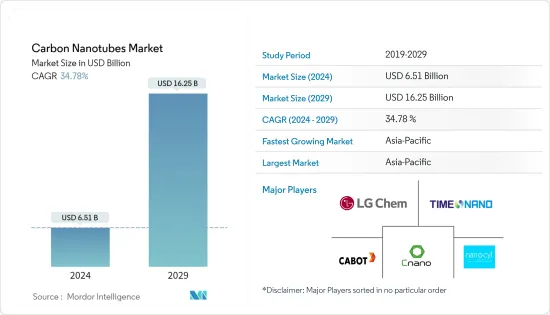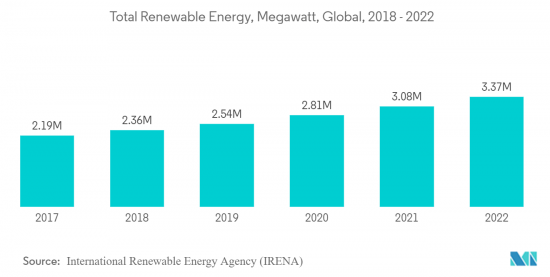 |
市場調查報告書
商品編碼
1403134
奈米碳管-市場佔有率分析、產業趨勢與統計、2024-2029 年成長預測Carbon Nanotubes - Market Share Analysis, Industry Trends & Statistics, Growth Forecasts 2024 - 2029 |
||||||
※ 本網頁內容可能與最新版本有所差異。詳細情況請與我們聯繫。
奈米碳管市場規模預計到2024年為65.1億美元,預計到2029年將達到162.5億美元,在預測期內(2024-2029年)複合年成長率為34.78%。

儘管COVID-19大流行奈米碳管市場帶來了各種挑戰,但它也提供了特定領域的成長機會。隨著世界從大流行中恢復,奈米碳管市場正在逐漸恢復勢頭,預計在預測期內將繼續成長。
由於能源、汽車、電子、航太和其他工業應用等各行業的應用不斷增加,市場需求增加。
從中期來看,奈米碳管在電動車中的使用不斷增加,以及許多應用中對先進材料的需求不斷增加,是推動市場的關鍵因素。
另一方面,環境問題和健康安全問題預計將抑制市場成長。
預計未來幾年對能源儲存設備的需求不斷成長對市場來說是個好兆頭。
亞太地區佔據最高的市場佔有率,預計該地區將在預測期內主導市場。
奈米碳管市場趨勢
主導市場的能源領域
- 由於其高表面積和導電性,奈米碳管作為主要用於太陽能電池、燃料電池催化劑和儲氫等能源應用的催化劑觸媒撐體而受到關注。這些獨特的性質使得奈米碳管可以用作能量轉換和儲存裝置中的輔助材料。
- 可再生能源的成長是由主要市場更雄心勃勃的擴張政策所推動的,部分原因是為了應對當前的能源危機。過去五年可再生能源的採用擴張速度加快主要歸因於兩個因素。
- 首先,全球能源危機導致石化燃料和電力價格急劇上升,增加了可再生能源發電技術的經濟吸引力。
- 其次,俄羅斯入侵烏克蘭導致石化燃料進口國,特別是歐洲國家,越來越強調可再生能源的能源安全效益。
- 儘管風能和太陽能補貼逐步取消,但隨著未來五年成長階段,中國將在 2022 年至 2027 年間佔全球可再生能源發電量的近一半。我們正計劃引入新的補貼。 「十四五」規劃中雄心勃勃的可再生能源目標、市場改革和地方政府的大力支持為可再生能源提供了長期收益確定性。
- 歐盟(EU)是僅次於中國的第二大成長市場,過去五年(2010年至2015年)再生能源可再生量穩定成長。然而,2022 年至 2027 年間,發展速度預計將增加一倍以上。甚至在俄羅斯入侵烏克蘭之前,一些歐盟成員國就已經制定了雄心勃勃的目標和政策,以加速可再生能源的部署,石化燃料到零。
- 在美國,可再生能源的部署在過去五年中幾乎加倍。 IRA 於 2022 年 8 月通過,將再生能源稅額扣抵延長至 2032 年,為風能和太陽能發電工程提供了前所未有的長期前景。在太陽能發電和競爭性競標的推動下,印度的競爭裝機量將在預測期內增加,以實現政府在 2030 年實現 500 吉瓦可再生能源的雄心勃勃的目標。預計將翻倍。
- 因此,這些因素預計將推動奈米碳管在能源產業的消費。

亞太地區主導市場
- 中國是亞太地區最大的碳奈米材料生產國和消費國。豐富的可用原料和低廉的生產成本支撐著該國碳奈米材料市場的成長。
- 由於其非凡的電氣性能,奈米碳管在電氣和奈米碳管應用中具有廣泛的應用,例如光伏、感測器、半導體裝置、顯示器、導體、燃料電池、收集器和電池。
- 中國擁有世界上最廣泛的電子產品生產基地,為韓國、新加坡和台灣等老牌上游生產商提供了激烈的競爭。智慧型手機、OLED電視和平板電腦等電子產品在家用電子電器領域成長最快。隨著中階可支配收入的增加,對電子產品的需求預計將成長,這將很快帶動奈米碳管市場。
- 印度政府正在與重要的半導體公司進行談判,以建立本地生產。印度政府已根據「印度改良半導體計畫」邀請從 2023 年 6 月起在印度設立半導體和顯示器工廠的新申請,投資額為 7,600 億印度盧比(約 100 億美元)。
- 印度在汽車產業進行了大量投資。汽車業近期的投資和發展計畫如下。
- 2023年1月,名爵汽車印度公司宣布投資1億美元擴大產能。 2022 年 12 月,Mahindra & Mahindra 透露計畫投資 1,000 億印度盧比(12 億美元)在浦那建造電動車製造廠。這項投資凸顯了電動車產業日益成長的重要性。
- 日本電子產品產業是拉動日本半導體銷售需求的最重要因素。日本約有 30 個半導體晶圓廠,涉及製造各種半導體晶片。日本半導體產量2021與前一年同期比較13%,2022年將成長10%,產值達30746億日圓(233.1億美元)。 2023年的成長率預計為1%。
- 根據日本工業協會(JAMA)的報告,2022年日本的小客車產量為7,427,179輛,卡車產量為1,286,414輛。這可能會影響奈米碳管市場。
- 因此,由於上述原因,亞太地區預計將在預測期內推動市場成長。
奈米碳管產業概況
全球奈米碳管市場本質上是部分一體化的,國際和國內的參與企業數量較少,分佈在不同地區。市場主要企業包括LG化學、成都有機化學(時代奈米)、卡博特公司、江蘇納諾科技、Nanocyl SA等。
其他福利:
- Excel 格式的市場預測 (ME) 表
- 3 個月分析師支持
目錄
第1章簡介
- 調查先決條件
- 調查範圍
第2章調查方法
第3章執行摘要
第4章市場動態
- 促進因素
- 擴大奈米碳管在電動車的使用
- 許多應用對先進材料的需求不斷成長
- 抑制因素
- 環境問題以及健康與安全問題
- 其他阻礙因素
- 產業價值鏈分析
- 波特五力分析
- 供應商的議價能力
- 消費者議價能力
- 新進入者的威脅
- 替代品的威脅
- 競爭程度
- 專利分析
第5章市場區隔(市場規模(金額/數量))
- 按類型
- 多壁奈米碳管(MW奈米碳管)
- 單壁奈米碳管(SW奈米碳管)
- 其他類型(扶手椅奈米碳管、鋸齒形奈米碳管)
- 按最終用戶產業
- 電子產品
- 航太/國防
- 車
- 醫療保健
- 能源
- 其他最終用戶產業(紡織、塑膠/複合材料、建築)
- 按地區
- 亞太地區
- 中國
- 印度
- 日本
- 韓國
- 其他亞太地區
- 北美洲
- 美國
- 加拿大
- 墨西哥
- 歐洲
- 德國
- 英國
- 義大利
- 法國
- 西班牙
- 歐洲其他地區
- 南美洲
- 巴西
- 阿根廷
- 南美洲其他地區
- 中東/非洲
- 沙烏地阿拉伯
- 南非
- 中東和非洲其他地區
- 亞太地區
第6章競爭形勢
- 合併、收購、合資、合夥和協議
- 市場佔有率(%)/排名分析
- 主要企業策略
- 公司簡介
- Arkema
- Cabot Corporation
- CHASM
- Chengdu Organic Chemicals Co. Ltd(Timesnano)
- Hyperion Catalysis International
- Jiangsu Cnano Technology Co. Ltd
- Kumho Petrochemical
- LG Chem
- Meijo Nano Carbon
- Nano-C
- Nanocyl SA
- Ocsial
- Raymor Industries Inc.
- Showa Denko KK(Resonac Holdings Corporation)
第7章 市場機會及未來趨勢
- 能源儲存設備需求增加
- 製藥領域需求量大的材料

The Carbon Nanotubes Market size is estimated at USD 6.51 billion in 2024, and is expected to reach USD 16.25 billion by 2029, growing at a CAGR of 34.78% during the forecast period (2024-2029).
The COVID-19 pandemic posed various challenges in the Carbon nanotubes market but also represented opportunities for growth in specific areas. The industry has adapted to the changing landscape in the automotive sector and various other advanced applications, As the world is recovering from the pandemic, the carbon nanotubes market is gradually regaining its momentum and will continue to grow during the forecast period.
The market saw a rise in demand with the increase in applications in various industries, including energy, automotive, electronics, aerospace, and other such industrial applications.
In the medium term, the major factors driving the market studied are the growing usage of carbon nanotubes in electric vehicles and the increasing demand for advanced materials in numerous applications.
On the flip side, environmental concerns and health safety issues are anticipated to restrain the market growth.
Increasing demand for energy storage devices is expected to act as an opportunity for the market in the coming years.
Asia-Pacific accounted for the highest market share, and the region is expected to dominate the market during the forecast period.
Carbon Nanotubes Market Trends
Energy Segment to Dominate the Market
- Carbon nanotubes (CNTs) received much attention as catalyst support for energy applications, primarily solar cells, fuel cell catalysts, and hydrogen storage, due to their high surface area and conductivity. These unique properties allow CNTs to be used as supplemental material for energy conversion and storage devices.
- Renewable growth is propelled by more ambitious expansion policies in critical markets, partly in response to the current energy crisis. The accelerated adoption of renewable energy in the last five years' expansion rate results primarily from two factors.
- First, high fossil fuel and electricity prices resulting from the global energy crisis made renewable power technologies much more economically attractive,
- Second, Russia's invasion of Ukraine increasingly caused fossil fuel importers, especially in Europe, to value renewable energy's energy security benefits.
- China plans to install almost half of new global renewable power capacity over 2022-2027, as growth accelerates in the next five years despite the phaseout of wind and solar PV subsidies. Ambitious renewable energy targets in the 14th Five-Year Plan, market reforms, and provincial solid government support provide long-term revenue certainty for renewables.
- The European Union, the second-largest growth market after China, had stable renewable capacity expansion in the past five years compared to 2010-2015. But its pace of development is expected to more than double during 2022-2027. While several EU member countries had already introduced ambitious targets and policies to accelerate renewable energy deployment before Russia invaded Ukraine since then, the European Union proposed even more aggressive goals under the REPowerEU package to eliminate Russian fossil fuel imports by 2027.
- In the United States, renewable energy expansion almost doubled in the last five years. The IRA passed in August 2022 extended tax credits for renewables until 2032, providing unprecedented long-term visibility for wind and solar PV projects. In India, new installations are set to double over our forecast period, led by solar PV and driven by competitive auctions implemented to achieve the government's ambitious target of 500 GW of renewable power by 2030.
- Therefore, these factors are projected to boost the consumption of carbon nanotubes in the energy industry.

Asia-Pacific to Dominate the Market
- China is the largest producer and consumer of carbon nanomaterials in Asia-Pacific. The abundance of available raw materials and the low cost of production supported the growth of the carbon nanomaterials market in the country.
- Because of CNT's extraordinary electrical properties, CNT finds applications in electrical and electronic applications such as photovoltaics, sensors, semiconductor devices, displays, conductors, fuel cells, harvesters, and batteries.
- China includes the world's most extensive electronics production base and offers tough competition to existing upstream producers, such as South Korea, Singapore, and Taiwan. Electronic products, such as smartphones, OLED TVs, tablets, etc., include the highest growth in the market in the consumer electronics segment. With the increase in the disposable income of the middle-class population, the demand for electronic products is estimated to grow, thereby driving the CNT market shortly.
- The Indian government is talking with significant semiconductor companies to set up local manufacturing. The government invited new applications for setting up Semiconductor Fabs and Display Fabs in India from June 2023 under the Modified Semicon India Programme with an outlay of INR 76,000 crore (~10 billion USD).
- The country saw large investments in the automotive sector. Recent and planned investments and developments in the automobile sector include
- In January 2023, MG Motor India announced a USD 100 million investment to expand capacity. In December 2022, Mahindra & Mahindra revealed plans to invest INR 10,000 crore (USD 1.2 billion) in an EV manufacturing plant in Pune. This investment emphasizes the growing significance of the EV sector.
- Japan's electronic products industry is the most significant factor driving demand for semiconductor sales in Japan. Japan includes about 30 semiconductor fab industries that are involved in the manufacturing of various semiconductor chips. Japan's semiconductor production registered a 13% y-o-y in 2021 and 10% in 2022, with production value reaching JPY 3,074.6 billion (USD 23.31 billion). The growth for the year 2023 is forecasted at 1%.
- As per the reports by the Japan Automobile Manufacturers Association (JAMA), the country produced 7,427,179 units of passenger cars and 1,286,414 units of trucks in 2022. It is likely to impact the CNT market.
- Hence, due to the reasons mentioned above, Asia-Pacific is anticipated to drive the market's growth during the forecast period.
Carbon Nanotubes Industry Overview
The global carbon nanotube market is partially consolidated in nature, with a few international and domestic players across different regions. Some of the major companies in the market include LG Chem, Chengdu Organic Chemicals Co. Ltd (Timesnano), Cabot Corporation, Jiangsu Cnano Technology Co. Ltd, and Nanocyl SA, among others.
Additional Benefits:
- The market estimate (ME) sheet in Excel format
- 3 months of analyst support
TABLE OF CONTENTS
1 INTRODUCTION
- 1.1 Study Assumptions
- 1.2 Scope of the Study
2 RESEARCH METHODOLOGY
3 EXECUTIVE SUMMARY
4 MARKET DYNAMICS
- 4.1 Drivers
- 4.1.1 Growing Usage of Carbon Nantotubes in Electric Vehicles
- 4.1.2 Increasing Demand for Advance Materials in Numerous Applications
- 4.2 Restraints
- 4.2.1 Environmental Concerns and Health Safety Issues
- 4.2.2 Other Restraints
- 4.3 Industry Value Chain Analysis
- 4.4 Porter's Five Forces Analysis
- 4.4.1 Bargaining Power of Suppliers
- 4.4.2 Bargaining Power of Consumers
- 4.4.3 Threat of New Entrants
- 4.4.4 Threat of Substitute Products and Services
- 4.4.5 Degree of Competition
- 4.5 Patent Analysis
5 MARKET SEGMENTATION (Market Size in Value and Volume)
- 5.1 By Type
- 5.1.1 Multi-walled Carbon Nanotubes (MWCNT)
- 5.1.2 Single-walled Carbon Nanotubes (SWCNT)
- 5.1.3 Other Types (armchair carbon nanotubes and zigzag carbon nanotubes)
- 5.2 By End-user Industry
- 5.2.1 Electronics
- 5.2.2 Aerospace and Defense
- 5.2.3 Automotive
- 5.2.4 Healthcare
- 5.2.5 Energy
- 5.2.6 Other End-user Industries (Textiles, Plastics and Composites, and Construction)
- 5.3 By Geography
- 5.3.1 Asia-Pacific
- 5.3.1.1 China
- 5.3.1.2 India
- 5.3.1.3 Japan
- 5.3.1.4 South Korea
- 5.3.1.5 Rest of Asia-Pacific
- 5.3.2 North America
- 5.3.2.1 United States
- 5.3.2.2 Canada
- 5.3.2.3 Mexico
- 5.3.3 Europe
- 5.3.3.1 Germany
- 5.3.3.2 United Kingdom
- 5.3.3.3 Italy
- 5.3.3.4 France
- 5.3.3.5 Spain
- 5.3.3.6 Rest of Europe
- 5.3.4 South America
- 5.3.4.1 Brazil
- 5.3.4.2 Argentina
- 5.3.4.3 Rest of South America
- 5.3.5 Middle East and Africa
- 5.3.5.1 Saudi Arabia
- 5.3.5.2 South Africa
- 5.3.5.3 Rest of Middle East and Africa
- 5.3.1 Asia-Pacific
6 COMPETITIVE LANDSCAPE
- 6.1 Mergers, Acquisitions, Joint Ventures, Collaborations, and Agreements
- 6.2 Market Share (%)/Ranking Analysis**
- 6.3 Strategies Adopted by Leading Players
- 6.4 Company Profiles
- 6.4.1 Arkema
- 6.4.2 Cabot Corporation
- 6.4.3 CHASM
- 6.4.4 Chengdu Organic Chemicals Co. Ltd (Timesnano)
- 6.4.5 Hyperion Catalysis International
- 6.4.6 Jiangsu Cnano Technology Co. Ltd
- 6.4.7 Kumho Petrochemical
- 6.4.8 LG Chem
- 6.4.9 Meijo Nano Carbon
- 6.4.10 Nano-C
- 6.4.11 Nanocyl SA
- 6.4.12 Ocsial
- 6.4.13 Raymor Industries Inc.
- 6.4.14 Showa Denko KK (Resonac Holdings Corporation)
7 MARKET OPPORTUNITIES AND FUTURE TRENDS
- 7.1 Increasing Demand for Energy Storage Devices
- 7.2 Highly Desired Material in the Pharmaceutical Sector













